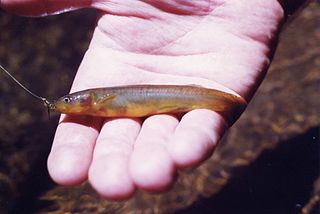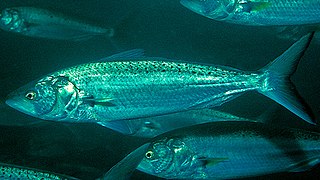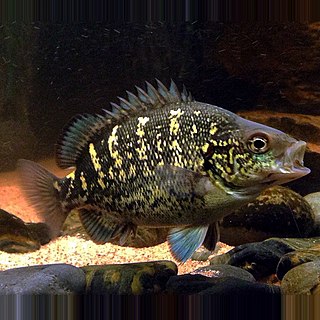
Arripis is a genus of marine ray-finned fishes from Australia and New Zealand, known as Australian salmon, kahawai and Australian herring. They are the only members of the family Arripidae. Despite the common name, Australian salmon are not related to the salmon family Salmonidae of the Northern Hemisphere, just as Australian herring are not related to herring of the Northern Hemisphere, but belong to the order Scombriformes of mackerel-like fishes. Australian salmon were named so by early European settlers after their superficial resemblance to salmonids.

The Galaxiidae are a family of mostly small freshwater fish in the Southern Hemisphere. The majority live in Southern Australia or New Zealand, but some are found in South Africa, southern South America, Lord Howe Island, New Caledonia, and the Falkland Islands. One galaxiid species, the common galaxias, is probably the most widely naturally distributed freshwater fish in the Southern Hemisphere. They are coolwater species, found in temperate latitudes, with only one species known from subtropical habitats. Many specialise in living in cold, high-altitude upland rivers, streams, and lakes.

The Australian herring, also known as the ruff, tommy ruff, or Australian ruff, is one of four Australasian fish species within the genus Arripis. It closely resembles its sister species, the Australian salmon, although it grows to a smaller size. Like the other members of its genus, it is found in cooler waters around the southern coast of Australia. It is not biologically related to the herring family Clupeidae.

The parore also known as luderick, black bream, black snapper or blackfish,, is a species of marine ray-finned fish, a sea chub from the family Kyphosidae which is found in the southwestern Pacific Ocean off Australia and New Zealand. Parore or paraore is the common name in New Zealand but in Australia luderick is preferred.

The New Zealand smelt, also known as the New Zealand common smelt, New Zealand cucumber fish, or silveries is a smelt of the family Retropinnidae, found only in New Zealand at shallow depths in estuaries and rivers. Their length is between 8 and 13 cm.

The Pacific staghorn sculpin is a species of marine ray-finned fish belonging to the family Cottidae, the typical sculpins. This species is found in the eastern Pacific Ocean. It is the only species in the monospecific genus Lepidocottus.

The Tasmanian mudfish, Neochanna cleaveri, is a small Australian amphidromous ray-finned fish in the family Galaxiidae.

Arripis trutta, known as the Australian salmon in Australia and as kahawai in New Zealand, is a South Pacific marine fish and one of the four extant species within the genus Arripis, native to the cooler waters around the southeastern Australian coasts and the New Zealand coastline. Other common names for this species include Eastern Australian salmon, bay trout, blackback salmon, buck salmon, cocky salmon, colonial salmon, woolley Judith, newfish and salmon trout.
The western galaxias, also called the western minnow, is a species of fish in the genus Galaxias of small, Southern Hemisphere freshwater fish of the family Galaxiidae. It is endemic to southwestern Australia.

Polydactylus sexfilis, the six-finger threadfin or yellowthread threadfin, is a species of marine ray-finned fish, a threadfin from the family Polynemidae which is found in the Indian and Pacific Oceans.

Leiopotherapon unicolor, the spangled grunter or spangled perch is a species of ray-finned fish, a grunter from the family Terapontidae. It is endemic to Australia.

Hephaestus carbo, the coal grunter or black grunter, is a species of freshwater ray-finned fish, a grunter from the family Terapontidae. It is endemic to rivers in northern Australia.

The blackfin slatey, also known as blackfoot sweetlips, blackfin sweetlips or blacktip sweetlips, is a species of marine ray-finned fish, a sweetlips belonging to the family Haemulidae. It is found in the eastern Indian Ocean and the western central Pacific Ocean.

The congoli, also known as the freshwater flathead, marble fish, marbled flathead, sand trout, sanding, sandy, sandy whiting or tupong, is a species of marine ray-finned fish. It is the only species of fish in the monotypic family Pseudaphritidae and the genus Pseudaphritis. It was initially classified as a member of the family Bovichtidae.

Lutjanus johnii, the Golden snapper, John’s snapper,big-scaled bream, fingermark bream, fingerbanger, fingermark seaperch, John's sea-perch, or spotted-scale sea perch, is a species of marine ray-finned fish, a snapper belonging to the family Lutjanidae. It is native to the western Pacific and Indian Oceans.
Bidyanus welchi, commonly known as Welch's grunter, black bream, or silver bream, is a species of freshwater ray-finned fish from the family Terapontidae native to Australia.

Arripis truttacea, the Western Australian salmon, is a species of marine ray-finned fish within the genus Arripis, the only genus within the family Arripidae. It is endemic to the seas off southern Australia.
Galaxias arcanus, the riffle galaxias, is a galaxiid of the genus Galaxias, a member of the Mountain Galaxias species complex group of freshwater fish, found in Australia.
Galaxias mungadhan, the Dargo galaxias, is a galaxiid of the genus Galaxias, a member of the Mountain Galaxias species complex group of freshwater fish, found in Victoria, Australia.
Galaxias oliros, the obscure galaxias, is a galaxiid of the genus Galaxias, a member of the Mountain Galaxias species complex group of freshwater fish, found in Australia.















